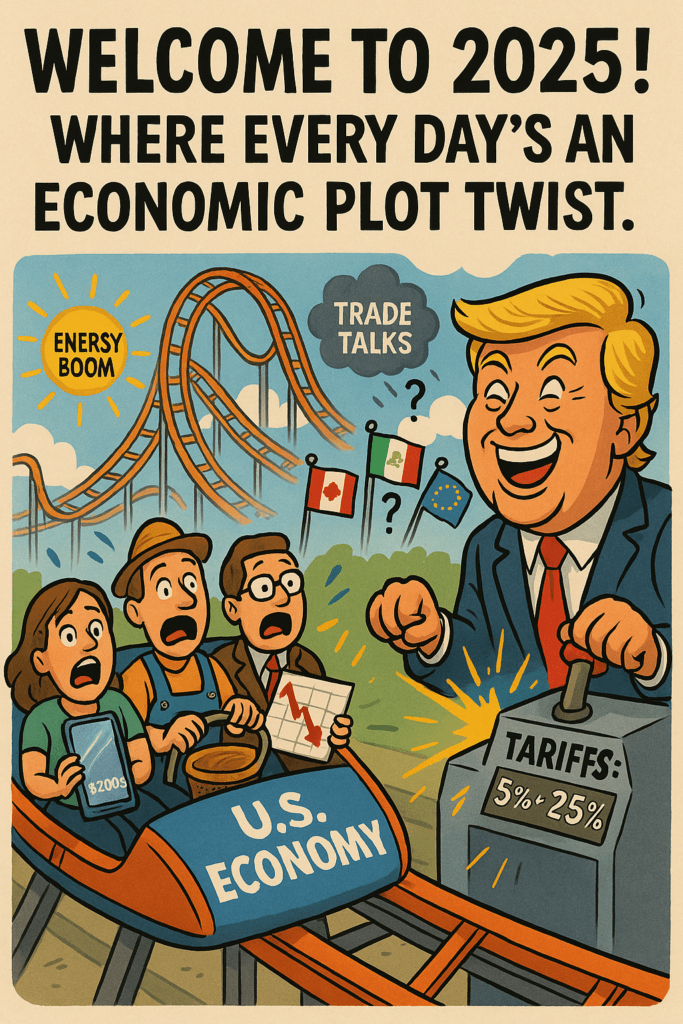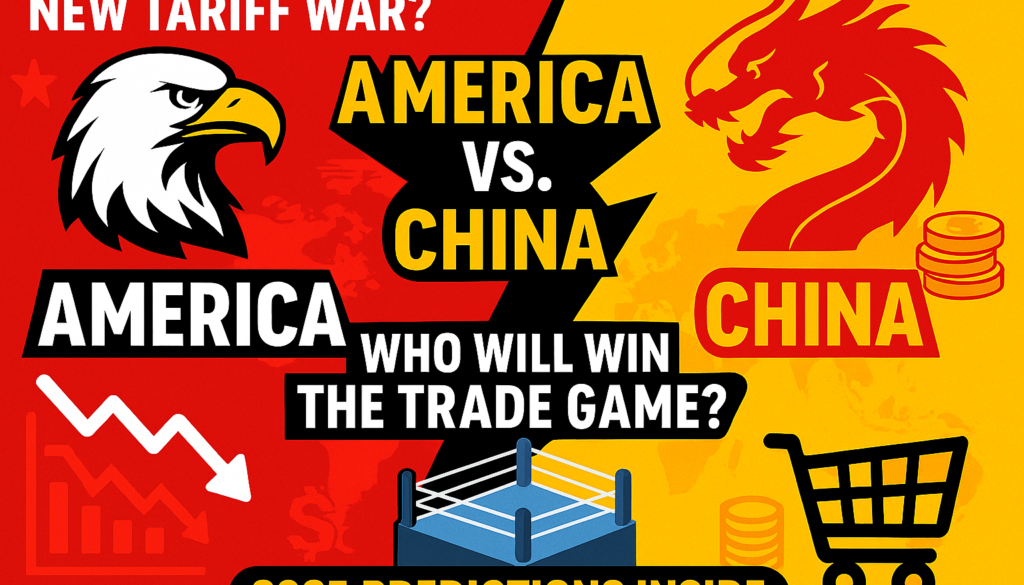Trump 50% Tariff on China 2025: Impact & Risks Explained
Hello friends, I’m Alex, and today we’re diving deep into a major economic move that’s got everyone talking: Donald Trump’s threat to impose a 50% tariff on goods from China in 2025. This isn’t just a policy shift- it’s a potential game-changer for the U.S., China, and the global economy. If you’re wondering what this means, why it’s happening, and how it could affect your wallet or job, you’re in the right place. Let’s get started!
What Are Tariffs, and Why Is Trump Targeting China with a 50% Tariff?
First things first: what’s a tariff? Think of it as a tax that a country puts on goods imported from another country. In this case, Trump is threatening to add a whopping 50% tariff on all goods coming from China into the United States. This isn’t a random decision—it’s part of a long-standing strategy Trump has used to address trade imbalances, protect American jobs, and push back against what he sees as unfair trade practices by China.
But why China, and why now? Let’s start with the background and then move to what’s happening today.

The Background: Trump’s Tariff History and U.S.-China Trade Tensions
Trump has been vocal about trade deficits since his first term as president from 2017 to 2021. A trade deficit happens when a country imports more goods than it exports, and with China, that deficit has been massive. In 2024, the U.S. imported about $438.9 billion worth of goods from China, while exporting only about $143.9 billion back, creating a trade deficit of around $295 billion. That’s a huge gap, and Trump has long argued that China benefits unfairly from this imbalance.
During his first term, Trump kicked off a trade war by imposing tariffs on Chinese goods. In 2018 and 2019, he put tariffs as high as 25% on items like steel, aluminum, and electronics, and even higher on things like solar panels and washing machines. His goal was to force China to stop practices like stealing intellectual property, subsidizing their industries, and flooding the U.S. market with cheap products. While some American manufacturers cheered, consumers and importers felt the pinch as prices rose.
These tariffs didn’t just affect goods—they also strained diplomatic relations. China retaliated by imposing tariffs on U.S. agricultural products like soybeans and pork, hurting American farmers. After some back-and-forth, the two sides signed a “Phase One” trade deal in early 2020, where China agreed to buy more U.S. goods and address some issues. But many experts say the deal fell short, and tensions never really cooled.
Now, in 2025, Trump is back in office with an even bolder plan. On February 15, 2025, he announced a baseline 10% tariff on all imports worldwide, calling it a way to level the playing field. Then, on April 2, 2025—dubbed “Liberation Day”—he escalated things by adding a 34% tariff specifically on Chinese goods, bringing the total tariff rate on China to 54% (20% from previous tariffs plus the new 34%). But that wasn’t enough. On April 7, 2025, Trump threatened an additional 50% tariff if China didn’t withdraw its own 34% retaliatory tariff by April 8, 2025. If that happens, the total tariff on Chinese goods could jump to 104%—a staggering figure that could reshape global trade.
ALSO READ : Global Trade War Ignites – China’s 34% Tariff on U.S. Sparks Chaos!
The Foreground: What’s Happening Right Now (April 8, 2025)
As of today, Tuesday, April 8, 2025, the situation is tense. China has refused to back down, calling Trump’s moves “economic bullying” and vowing to protect its interests. On April 5, 2025, China announced a 34% tariff on all U.S. imports, effective April 10, 2025, as a direct response to Trump’s actions. This tit-for-tat escalation has sent shockwaves through financial markets, with global stock indices like the S&P 500, FTSE 100, and Hang Seng dropping sharply over the past few days. The S&P 500, for instance, fell more than 5% in early April, entering what some call “bear market” territory, as investors fear a recession.
Trump, however, isn’t budging. In posts on social media platforms like Truth Social and statements from the White House, he’s doubled down, saying the tariffs are “medicine” the U.S. needs to take to fix decades of unfair trade. He’s also opened negotiations with other countries, like Japan and Israel, but with China, he’s taken a hard line, even threatening to cancel all talks unless China retracts its tariffs by tomorrow, April 9, 2025.
Meanwhile, economists and business leaders are sounding alarms. BlackRock CEO Larry Fink recently said most CEOs he talks to believe the U.S. is “probably in a recession now,” while JPMorgan has raised its recession probability to 60% by the end of 2025. Consumers are bracing for higher prices on everything from electronics to clothing, as companies like Apple and Walmart that rely on Chinese supply chains face higher costs. Farmers in the U.S. Midwest are worried too, as China’s retaliation could slash demand for their soybeans and corn.
ALSO READ : Trump’s Tariff Era Kicks Off on April 2, 2025 – India’s Pharma Shines Amid Global Chaos!
Why Does This Matter?
Tariffs might seem like dry economic policy, but they have real-world impacts. Here’s why Trump’s 50% tariff threat on China is such a big deal:
Higher Prices for Consumers
When tariffs go up, importers often pass those costs to you and me. Studies from Trump’s first term show that most of the tariff burden on Chinese goods was passed on to U.S. consumers, raising prices by an estimated 4-5% on affected products. With a 50% tariff, that could mean an extra $3,789 per household per year, according to the Yale Budget Lab. Imagine paying more for your iPhone, sneakers, or even furniture—that’s the reality we’re facing.
Job Impacts
Trump says tariffs will bring jobs back to the U.S. by making it cheaper to manufacture here than import from China. Some industries, like steel and auto parts, might see a boost. But there’s a catch: higher costs could force companies to cut jobs or move production to other countries like Vietnam or Mexico, where costs are still lower. Farmers, exporters, and retailers could also suffer if China’s retaliation hits hard.
Global Trade War Risks
This isn’t just a U.S.-China fight. Other countries are getting dragged in. The European Union has proposed 25% counter-tariffs on U.S. goods, while countries like India and Taiwan are watching closely. If this spirals into a global trade war, supply chains could collapse, shipping costs could soar, and international trade could shrink by 5-10%, according to Moody’s ratings agency. That’s a recipe for a global recession.
Geopolitical Tensions
Beyond economics, this is about power. The U.S. and China are the world’s two largest economies, and their rivalry extends to technology (think 5G and AI), military influence, and global leadership. Trump’s tariffs are a way to assert dominance, but China sees them as an attack on its sovereignty. This could lead to broader conflicts, from cyberattacks to diplomatic freezes.
ALSO READ : Trump’s Massive Tariffs on April 2, 2025 – A Global Shake-Up Unveiled!
Table 1: Tariff Rates and Impacts Comparison (2025)
Here’s a detailed comparison of tariff rates and their potential effects:
| Country | Previous Tariff Rate | New Tariff Rate (April 2025) | Proposed Additional Tariff | Expected Impact on U.S. Consumers | Expected Impact on China |
|---|---|---|---|---|---|
| China | 20% | 54% (20% + 34%) | +50% (potential 104%) | Higher prices (up 10-15%), supply chain disruptions | Export drop of 50-90%, GDP hit of 2-4% |
| Canada | 0% | 25% (exemptions possible) | None planned | Moderate price increases | Minimal direct impact |
| Mexico | 0% | 25% (exemptions possible) | None planned | Moderate price increases | Minimal direct impact |
| European Union | 0% | 20% | None planned | Higher prices for EU goods | Retaliatory tariffs likely |
| Global Baseline | 0% | 10% | None planned | Slight price rise, broad impact | Indirect pressure on China |
This table shows China facing the heaviest burden, with potential losses in exports and economic growth. The U.S. might see some manufacturing gains but at the cost of higher consumer prices and global instability.
Tariffs aren’t just numbers—they affect real people. Here’s a breakdown:
Winners
- U.S. Manufacturers: Companies making steel, aluminum, or auto parts in the U.S. might see a boost as imports become costlier. For example, U.S. Steel could gain if Chinese steel is priced out of the market.
- Tariff Revenue: The U.S. government expects to collect billions in tariff revenue, which could fund infrastructure or tax cuts. Estimates suggest $200-300 billion annually from all tariffs, with China contributing the lion’s share.
- Some Workers: Jobs in tariff-protected industries could grow, especially in states like Pennsylvania and Ohio, key swing states for Trump.
Losers
- Consumers: You and I will likely pay more for goods. A study by the Federal Reserve Bank of New York found that Trump’s earlier tariffs raised household costs by about $419 annually on average. With a 50% tariff, that could double or triple.
- Importers and Retailers: Big retailers like Walmart, Target, and Amazon, which source heavily from China, face higher costs. They might cut profits, raise prices, or even lay off workers.
- Farmers and Exporters: U.S. farmers, especially in the Midwest, could see demand for soybeans, corn, and wheat drop if China retaliates further. In 2018, Chinese tariffs cost U.S. farmers $12 billion in lost exports.
- Global Supply Chains: Companies like Tesla and Apple, which rely on Chinese parts, could face delays and cost increases, potentially slowing innovation and growth.
What Could Happen Next? Possible Scenarios
The next few days are critical. Here are the main scenarios as of April 8, 2025:
China Backs Down
If China withdraws its 34% tariff by tomorrow, Trump might hold off on the 50% tariff. This would calm markets but might embolden him to demand more concessions later. China’s leaders, however, have signaled they won’t cave, calling it a matter of national pride.
Escalation
If China doesn’t back down, the 50% tariff kicks in on April 9, 2025. China could then raise its tariffs even higher, say 50% or more, and both sides could dig in for a prolonged trade war. Analysts like Goldman Sachs predict this could shrink global trade by 5-10% and raise the recession risk to 45-60%.
Negotiations
Trump has said he’s open to talks with other countries, and more than 50 nations have reportedly reached out. But with China, he’s set a hard deadline. If both sides agree to negotiate, they might lower tariffs incrementally, but trust is low, and progress could be slow.
ALSO READ : Mohammad Yunus’s controversial statement on India’s Northeast unites BJP and Congres
Global Ripple Effects
Even if the U.S. and China find a middle ground, other countries like the EU, India, and Brazil might impose their own tariffs, creating a domino effect. Oil prices have already dropped 2% to a four-year low due to recession fears, and copper prices—a key economic indicator—are falling, signaling slowdown.
The Economic and Social Fallout: A Deeper Look
Let’s zoom in on the potential fallout. Economists warn that a 50% tariff could:
- Raise Inflation: Higher import costs could push U.S. inflation above the Federal Reserve’s 2% target, forcing interest rate hikes that slow growth. Fed Chair Jerome Powell has hinted at caution, but market volatility might force his hand.
- Hurt Small Businesses: Small retailers and manufacturers that rely on Chinese components (e.g., electronics, toys) could struggle. A survey by the National Federation of Independent Business found that 67% of small business owners are worried about tariff impacts.
- Shift Supply Chains: Companies might shift production to countries like Vietnam, Mexico, or India. While this could diversify global trade, it could also cause short-term disruptions, with shipping delays and higher logistics costs.
- Impact Developing Nations: Countries that export to both the U.S. and China, like South Korea and Taiwan, could get caught in the crossfire. Their economies might shrink if demand drops or supply chains break.
On the social side, posts on X show a mix of opinions. Some users support Trump, saying, “China’s been cheating for years, it’s time they pay.” Others warn, “This could crash the economy and raise prices for everyone.” Public protests in cities like New York and Los Angeles have highlighted fears of job losses and higher costs, while farmers in Iowa and Kansas are organizing to lobby for relief.
Why This Matters to You, No Matter Where You Live
Even if you’re not in the U.S. or China, this affects you. Global trade connects us all. If the U.S. and China fight, prices for goods like electronics, clothing, and even food could rise worldwide. If you work in manufacturing, retail, or logistics, your job might be at risk. And if a global recession hits, investment, wages, and growth could stall everywhere.
For example, if you’re in Europe, the EU’s counter-tariffs could raise costs for U.S. imports like cars or tech. If you’re in Asia, your country’s exports to both the U.S. and China might drop. No one is immune.
Final Thoughts
This is a big moment. Trump’s 50% tariff threat on China could protect some American jobs and reduce trade deficits, but it risks higher prices, a global trade war, and a recession. China’s refusal to back down shows this won’t be easy to resolve. As consumers, workers, and citizens, we need to stay informed and advocate for policies that balance fairness with stability.
What do you think? Are you worried about higher costs, or do you support Trump’s strategy? Drop a comment below—I’d love to hear your thoughts!




